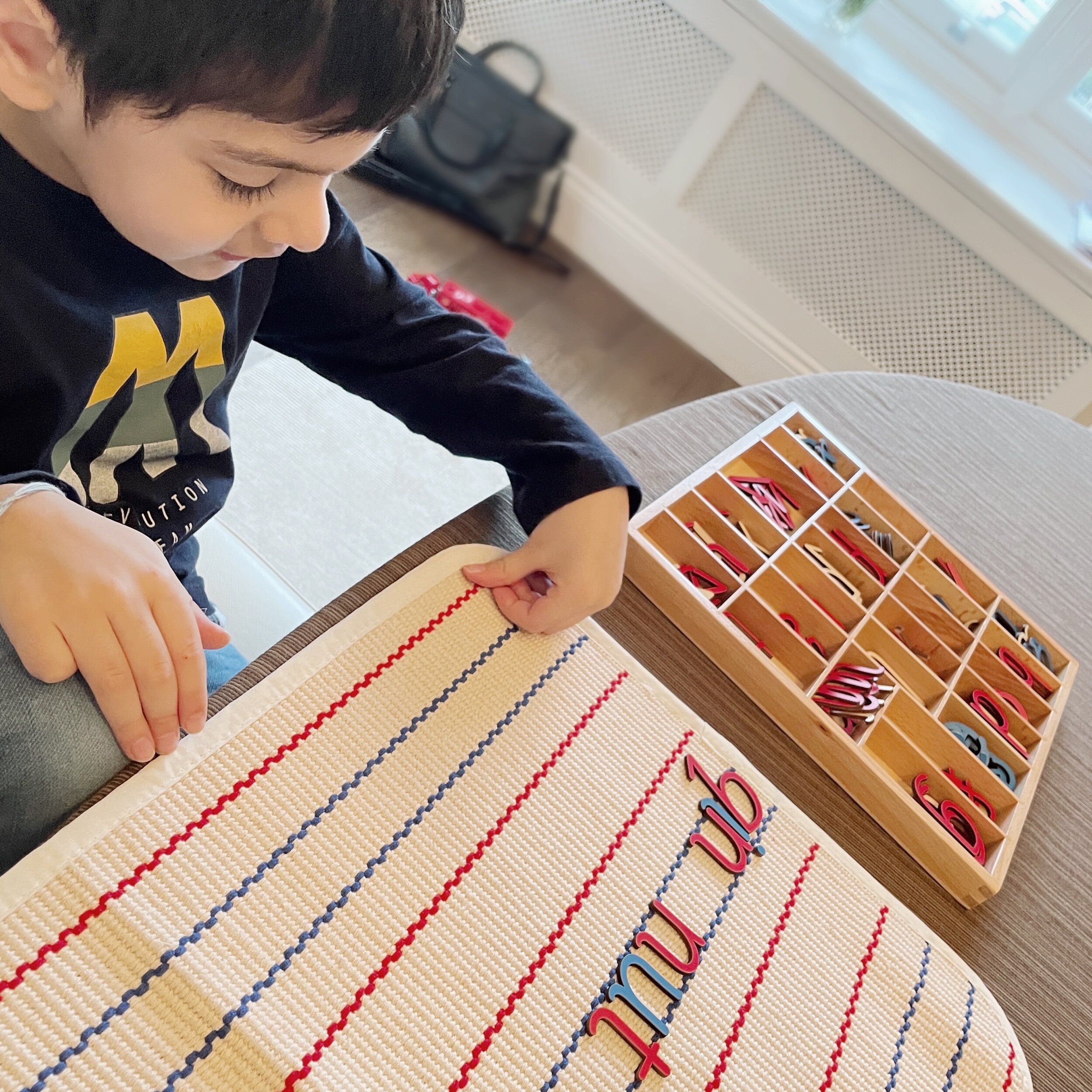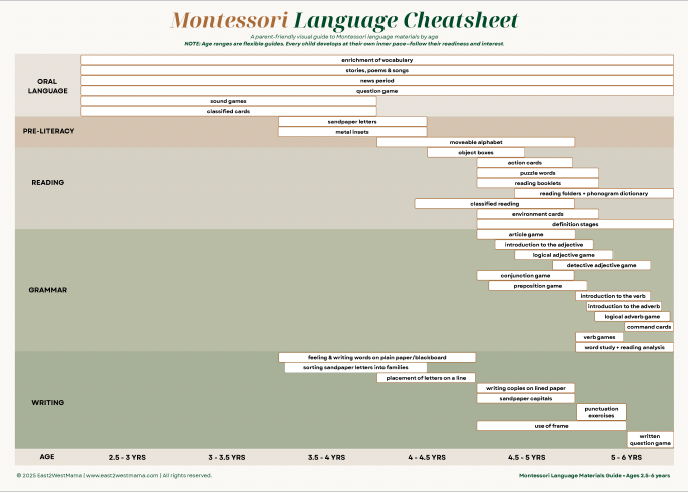Montessori Moveable Alphabet: What is it and how do I use it with my child?
This article may contain affiliate/compensated links. For full information, please see our disclaimer here.
The Montessori movable alphabet is a set of wooden lowercase letters with blue vowels and red consonants, which children use to form words. This post will introduce you to the Montessori moveable alphabet, show you when and how to use it with your child and give you suggestions on where to get it.
What is the moveable alphabet?
The moveable alphabet is a key material used in the Montessori approach to reading and writing. The moveable alphabet gives a child the ability to express himself in written words, without being able to hold and write with a pencil.
This informative tweet by Ruth Swailes reveals an X-ray of a child’s hand (around age 7) compared with a child in early years (age 4 or 5). You can see how underdeveloped the hand is in the preschool years, and how much more development has to occur in the fingers and wrist before the full range of movement is achieved.
Image of 7 year old hand versus hand of early years child.
Source: Ruth Swailes #FFF @SwailesRuth
This just goes to show that in the early years, children are not physically ready to write, but they are ready for word-formation. This is where the moveable alphabet comes in.
For many children, being introduced to the moveable alphabet is an exciting transition. Prior to this stage, they have only been working with sandpaper letters. The moveable alphabet allows them to put together the various letter sounds they have learned to form words, thus allowing them to begin expressing themselves using the written word.
The traditional Montessori movable alphabet comprises wooden lowercase letters, with blue vowels and red consonants. They are placed in a wooden box with 26 compartments so that a child can easily locate the alphabet he needs to form a word.
Ryaan using the Montessori moveable alphabet for the first time.
When do I introduce the moveable alphabet?
There are several stages in the Montessori approach to language development. The moveable alphabet should be introduced in the word-formation stage after children are familiar with all sandpaper letters and their corresponding sounds. They should also be very adept at listening to the different sounds that make up words (beginning, middle and ending sounds) and should also be beginning to blend them together. (e.g. ‘c’, ‘a’, ‘t’, ‘cat’)
Observation of the child is key to determining when they are ready for any Montessori material.
How do I use the moveable alphabet with my child?
There are several stages in using the moveable alphabet, and you can start at any of these steps, depending on your child’s readiness.
Introduction to the moveable alphabet
If your child has never worked with the moveable alphabet before, the first lesson should be about familiarising them with the material. Take the box off the shelf, place it on a rug and have a look at it together. Name the material - ‘this is the moveable alphabet.’
Start by showing your child how to straighten and stack the letters in each compartment so they can be seen clearly. Then pick a letter, take it out of the box and place it on the rug. Name the letter while having a feel of it, then place it back in its compartment. Let your child have a go at it too. Keep doing this and letting your child explore the material and get familiar with it.
Matching with sandpaper letters
The next step is to match the letters of the moveable alphabet with sandpaper letters that your child is already familiar with. To do this, pick three to five sandpaper letters and place them on a rug next to the moveable alphabet. Pick one sandpaper letter, then scan the moveable alphabet to find the same letter. Place the moveable alphabet letter below the sandpaper letter on the rug. Repeat for the remaining letters, then let your child have a go. Keep going as long as the child is still interested.
It might be useful to do this exercise with all 26 alphabets so the child becomes familiar with their placement in the moveable alphabet box. If it seems as though they are familiar enough and ready to start forming words, then move on to the next step.
Forming CVC words using language objects
The next stage is to use the moveable alphabet to start forming simple CVC (consonant-vowel-consonant) words. In Montessori, this stage corresponds with the Pink Series. The Montessori Pink Series is a set of language words following the CVC format, usually paired with corresponding boxes of tiny objects for more tangible learning.
[Note: If using the Waseca reading program (which is what we use), this stage corresponds with the Red set. Click here for $15 off your purchase.]
Each box contains tiny objects with the same short vowel sound, e.g. ‘a’ as in ‘cat’, ‘bat’, ‘mat’ and ‘rat’.
Place the objects on the rug, then use the moveable alphabet to start spelling out the word. Demonstrate it with one or two objects, then let your child have a turn. Do not correct their spelling at this stage, as we want to build confidence and encourage them to write what they hear.
Keep going with the same vowel sound until mastered, then provide objects corresponding with the next vowel.
The video below shows this step in action.
Creating CVC words using Montessori moveable alphabet
We got our language objects from TTS Sound and Phonics Tubs and from the Safari Ltd Toobs available on Amazon. A few examples are listed below, but Toobs are available in many different categories.
If you would prefer not to invest in language objects, then Pink series picture cards can be used instead.
4. Forming words with consonant blends
Once the child has mastered the formation of CVC words, he is ready to move on to words with consonant blends. In Montessori, this stage coincides with the Blue Series. These words consist of consonant blends at the beginning or end of the word, or both, e.g. “crab”, “lamp”, “block.” There are about 20 different blends if you include doubles like “ll” and “ss”.
Similar to the presentation in Step 3, objects can represent words, which the child then spells out using the moveable alphabet. Blue Series picture cards can also be used in place of language objects at this stage.
[Note: If using the Waseca reading program (which is what we use), this stage corresponds with the Orange, Yellow and Green sets. Click here for $15 off your purchase.]
5. Writing phrases and short sentences
By this stage, your child knows how to form enough words to ‘write’ phrases, sentences and even short stories using the moveable alphabet. Your child can tell his own story or can be given picture cards as a prompt. We like this set of story sequence cards, even though Ryaan isn’t at the stage to use them with the moveable alphabet yet.
Stop guessing when to introduce Montessori language materials.
Grab my free Montessori Language Cheatsheet and see exactly how reading, writing, and language materials fit together from ages 2.5–6.
This visual timeline shows you when to introduce each material so you can confidently guide your child's literacy journey… without the guesswork.
Get the cheatsheet + weekly Montessori inspiration
Sign up for my newsletter and receive:
✅ Instant access to the Montessori Language Cheatsheet
✅ Practical Montessori activities for home (ages 0-6)
✅ Screen-free play ideas that actually engage your kids
✅ Gentle parenting tips from real-life experience
No spam, just helpful resources from one mum to another. 💛
Join 12,000+ parents doing Montessori at home.
Where can I get the moveable alphabet from?
My favourite source for Montessori materials in the UK is Absorbent Minds, and these are the moveable alphabet sets they carry. Some sets available on Etsy are the felt moveable alphabet from here and the small print moveable alphabet from AffordMontessori.
In my opinion, the moveable alphabet is a Montessori material that is worth investing in. Even if your child attends a regular school or a Montessori school, the moveable alphabet can be used for a long time to aid in the development of a child’s written language. However, if it is still out of your budget, then a set of magnetic letters from Amazon would also work. It is worth noting that the colours in this set are opposite to that of the Montessori material, but they still serve to distinguish vowels from consonants, so they shouldn’t make too much of a difference. I would also remove the uppercase letters from the set, especially when first introduced to a child.
Another option is to DIY a set of letters, here is a great tutorial on how to do so.
As touched on briefly above, we use our moveable alphabet in conjunction with the Waseca Reading Program. The program provides a systematic and sequential presentation of the phonetic elements used in the English language. It comprises nine levels, each with seven sub-sections introducing a different phonetic element.
I will do a full review of our experience with the program soon, but for now, you can head to my Instagram page for a short video of Ryaan working with the Waseca Red set and the moveable alphabet.



